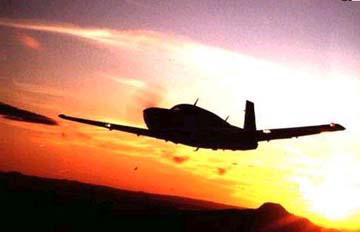
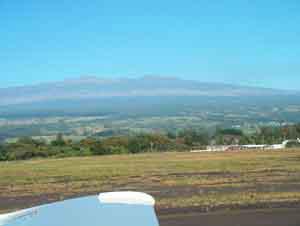
March 11, Hilo, Hawaii to American Samoa, 3rd leg flight report
What a frustrating morning.... but, I'm finally on my way. Got up at 4:30am and did a final weather check -- looked great, no BIG fronts or weather. Just like the weatherman said, just a few isolated thunderstorms, easy enough to deviate around. The wind chart was missing it's arrows, but yesterday it looked like a quartering tailwind. At the airport, I checked everything, ran each of the fuel tanks to make sure all the air was out, then I called ground when Hilo tower opened at 6am. Clearance received, beautiful takeoff and climb east bound, beautiful day, I'm on my way, or so I thought.
Hilo departure asks me to switch to HF to make sure contact is good or they can't let me continue out of their airspace. I think, no problem, HF communication was great all the way over. I switch to HF and nothing...I keep testing, checking wires and calling for half an hour. The transmission looks strong on the meter. They make me return, then give me another freq to try. The antenna is reeled in and out twice. I'm exhausted and very frustrated. Finally I return and land, heavy (full of fuel).
It has to be something I bumped getting in or out.... I recheck everything. I lay out the antenna and check the email as it's the only thing I can hear/receive. The gas guy, Tim, puts the antenna on top of a ladder on top of his truck. Reception is VERY weak. I recheck all the cables, plug in the headset directly. Then, when turning the power on, I must have hit the transmit button, just beneath. I hear static finally -- what a relief. I know now that that was the problem.
I gas up again, Tim gives me a hug (he'd checked up on me every time I was at the plane and we'd talked quite a bit over the past few days) and says "Aloha Nui" and I startup, taxi and take off. I ask to switch to HF and start testing. No reception. I keep climbing and hear some weak voices. As I climb above 3000 I can hear pretty well. I call and SF radio calls back clear as a bell!! I'm on my way!! I can tell you, it's no fun reeling the antenna in and out while climbing and descending.
Hilo departure continues to give me vectors to an intersection and clearance to American Samoa. If they lose me on VHF, I'm to call SF radio and check in with them. After 100 miles, I hear center calling, but they can't hear my response, so I go back to SF radio and call, and call. No response, my heart sinks. I'm going to have to return again. I switch to the secondary frequency they gave me and they come in loud and clear. Pheww, I can continue on my way. Ok, now I can get down to flying and position reporting.
There are little puffy clouds all around, then I'll pass over an open area, then more little puffy clouds. I'm not looking forward to the thunderstorms, but at least they are isolated, unlike last week when the satellite photo looked red all across my route. First position report went ok, check in with HF friend from Kona, Bob, NH6GB, second position report ok, then while getting ready for Ben's net, I lost static again...... uuuhhhh..... again I wiggle all the wires, no static. I call SF radio, and can hear them over the HF speaker, but not through the headset. As Wes, my HF guru in Florida knows, electrical stuff is not my forte. If wire wiggling doesn't work, I don't have too many options left. After re-wiggling with no luck, I unplug the headset wire from the VHF/HF interface box and plug it directly into the HF transceiver. I have static again. I call SF radio and all is well. They must think I'm a waco!! It's past Ben's net time, so I switch and listen. I can't hear anything, but I transmit anyway. AH6BR, Scott, a relative of a friend of my Dad's in Virginia, comes up and we chat for a while. He has to go, so we set 3pm for another chat.
Back to flying and position reporting... decidedly, this is my day for HF problems. But, it keeps my mind off other things, like being bored. Just in case you are wondering, pilots out there, yes, I'm checking the gages and GPS and instruments while all this is going on! Next position report went fine, almost three and a half hours into the flight, only 12 hours to go. Weather still looks good and I've had a 5 knot tailwind so far. Actually, the oil temp and cylinder head temp were slightly higher than their normal reading, not surprising with the engine running a higher RPM. I back off the RPM to 2450 and after several minutes, both gages go down slightly. I don't want to overheat the poor little engine. Maybe I'm more in tune with the engine as the sun is pouring in the left front window and I'm frying. I don't want to fry and I don't want to fry my engine. Only 180 miles to go and I can make a 10 degree left turn and get the sun off my shoulder. Another good position report; I'm regaining confidence that the HF reception problems are behind me. I really, really don't want to turn around from here. SF radio is sounding loud and clear and it's a joy to hear them each hour.
I'm wondering if I'll see the equator on the GPS. Guess I'll find out in several hours. Only 10 degrees 50 minutes north right now. I'm also wondering when to switch the GPS chip from the Americas to International. I downloaded it before leaving. American Samoa is supposed to be on the new chip, but, so far, the old chip is showing that it knows where Pago Pago is. Ah ha, she says after playing with the GPS. I can get there on the old chip, but the approaches will be on the new chip. I think I'll wait until I'm pretty close before I change the chip in the GPS. No sense testing it way out in the middle of no-where.
Since it was daylight by the time I left the second time, I had a few minutes to look around and take pictures while awaiting my clearance. Left is the small Hawaiian Air Academy/Sporties with tie down for transient parking in front. That's where I was. Right, you can see one of the volcanos with the observatory on top. It's a beautiful clear morning, but, if it's like the other days, the clouds will roll in and cover the top from view.


Ok, lunch time, what's on the menu today? Turkey sandwich with lettuce and tomatoes, ginger snaps for desert and Cheerios and an apple for snacking. Healthy!! And, by the way, that's dinner as well. Just checked the last leg's fuel consumption, 8.2 gal/hr and 1 qt of oil. Excellent. My speed is down to 142 knots from 150k as I turn more to the south from a southwesterly direction and the wind continues from the east. I still have a 4k tailwind and I'm happy with that.
Jose' Monroy, from Monroy Aerospace, who put in my extended wing tanks (which work GREAT by the way) has emailed me after each leg. He suggested a view of the cabin and the tight quarters I'm in. Jose' flies long overseas flights to the Caribbean and Spain in his Mooney, so he knows what I'm going through. That's also why he designed the long range tanks for Mooneys. Right photo is the copilot's side with a 17 gallon fuel tank underneath, the HF radio and my flight bag on the right, and my laptop to the left. Yes, that's how I write all these updates, as I'm flying and right after each event occurs.

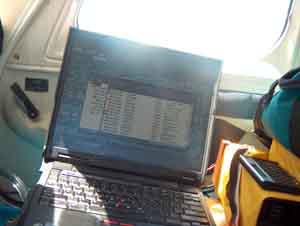
Left, is the view behind me: the 55 gal tank covered with non-skid takes up most of the back seat. On top is ditch bag to the left and life raft on the right. The life raft sits behind my seat for takeoff; but after 3 hours or so, I lift it on top of the gas tank and slide my seat back. Another friend emailed me because he was headed to New Zealand on a business trip in economy class. He wasn't complaining about being cramped, he was wishing he could fly with me instead!! Sorry, no room.
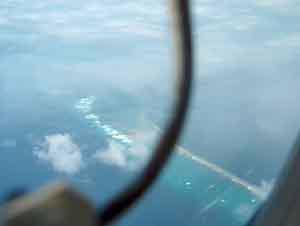
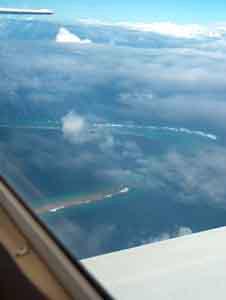
Wow!! Land ho!! In the middle of the Pacific, 6hr 18 min out from Hawaii. I can't believe it. I saw waves through the clouds, then looked closer. It's not on the GPS. Scott, the Ham from Hawaii, said that I might pass over Palmyra Atoll, well, he was right. He also said there was an old WWII runway on it, but I couldn't see the whole island nor any runway on the part I could see. I put a GPS waypoint in just in case I need to swim back!!
And now, after the last position report, the nice radio person followed the "roger" with "talk with you in an hour." Actually, it's comforting to have to talk with someone every hour. It reminds me of why I got my ham radio license in the first place. I was sailing, actually in a motor trawler, from the Canary Islands to Dakar on the west coast of Africa in Senegal. We were 7 days on the ocean. Not a long crossing for real sailors, but a first for me (I was the third person, invited by the other two to help out with watches/shifts during the crossing) the other two had been sailing together for many years. I was happy to be with them and helping out; it was a fun trip. But, what struck me was that we talked with other people only twice a day. The captain had a ham radio and called in to two nets to receive the latest news and to report how we were doing. To me, not used to this life style, it was like a life line to the rest of humanity. After the trip was over, I ordered the ham radio books and started studying. My Mother already had her General license and my Dad had his Novice, so they sent me all the info and tapes to practice morse code. Four months later I sat for my General license and passed. I haven't used it much, but now on this trip, it feels like a life line each hour. Also, talking with other hams, between the position reports, makes the trip and contacts more personal. They can also relay information back to friends and family.
Just made it through the first set of clouds. I'd seen some CBs developing in various quadrants, but none directly ahead. I had low level clouds and some cumulus up to maybe 12-15,000 ft. I shut everything down and tied everything down, then the rain started. It wasn't bumpy at all. Half an hour later I was through. Not bad. Last week would have been terrible, if I'd even departed. This is the ideal weather, as good as it gets, (or that's what the weatherman said yesterday).
Eleven hours into the flight, the sun is just starting to set at 6:30pm American Samoa time. I've been through multiple cloud banks, nothing serious, just some cumulus and a little rain. Still clear ahead, no towering CB and I haven't seen any hits on the storm scope the whole trip. The tailwind has picked up and I'm running 158-160 knots. Still 4 hours to go, but it looks smooth.
I'm reaching ELLMS intersection; that's a FIR boundary. I don't know exactly what's going to happen but I assume they'll tell me. As I make my normal position report to SF radio, they take the information and ask me to call Auckland radio. I call but am unable to reach anyone. I return to SF radio. I'm pretty calm, because this time, there's not much I can do but continue. I finally reach Auckland radio and he takes my position report and asks where I'm going and where I'm from.
It's time to change the GPS chip. It's not reading any more intersections that are on the chart. But, I'm a chicken, I'll follow the magenta line to Pago Pago and change the chip when I've got VOR or ADF reception. 100 miles out and I'm switched to VHF. I put in the new chip and load the approach. Although there's an ILS in the approach book, the GPS only has two VOR DME arc approaches, oh well. I load the one from the north as the wind is light and variable. There are some peaks and cables across the bay, so I watch the altitudes very carefully and descend slowly. Finally I'm down, 15hr and 12 minutes of flying. Time to find GA parking and a hotel!!
A Day in American Samoa:
After a good night's sleep, I went to check on Customs, landing fees, fueling, weather, etc. If I wanted to leave tomorrow, I had a lot to do today. 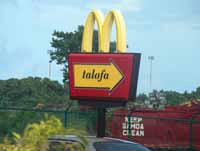
Actually I wanted a local breakfast first.... there was none. It was recommended that I eat at McDonalds, down the street. I don't even eat at McDonalds in the US. But, I was starving, so Egg McMuffin it was.
The customs people were the same as were there the previous night. They had had 2 hours of overtime for a cargo plane that arrived just after me. They relieved me of $50 but waived the overtime charge (that was very nice) and explained that it covered the landing and departure fees also. Not too bad; next stop fuel.
I walked around and found a Polynesian Airlines pilot. He was fascinated with my trip but didn't know where to get gas. He suggested visiting the tower for weather information. I hadn't thought of that, thanks Wade. Next stop any open office to find out about gas. The first one did it, I think it was Samoan Air. The woman manager called several places then said that the fueler would meet me at my plane!! What service.
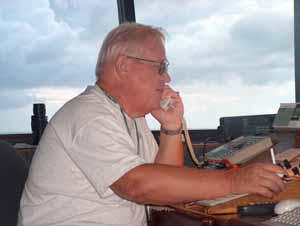 I walked to the tower, not really thinking that I'd get in. But, Frank was very kind, answered all my questions, showed me where the weather office was (just below the tower) and open 24 hrs a day. We talked and he reminded me about filing my flight plan early because of advising the next countries' controllers. I retrieved all my charts and flight plan materials and returned. We poured over the details, then filed it directly through his computer, even though he's not a FSS. The Tonga controller called to confirm my flight and arrival in his sector.
I walked to the tower, not really thinking that I'd get in. But, Frank was very kind, answered all my questions, showed me where the weather office was (just below the tower) and open 24 hrs a day. We talked and he reminded me about filing my flight plan early because of advising the next countries' controllers. I retrieved all my charts and flight plan materials and returned. We poured over the details, then filed it directly through his computer, even though he's not a FSS. The Tonga controller called to confirm my flight and arrival in his sector.
He shared with me the information he'd received about my arrival the previous day, even though he knew I'd arrive after he closed. What looked like an old teletype page, now done by computer, had the positions of the planes coming his way. It showed my original departure at 1616z, when I first left Hilo. It showed my arrival at Laker, the Pago TCA/FIR and advised HF communication at that point (a little difficult as Pago doesn't have HF). He and his boss, Greg, gave me a lot of insight as to how
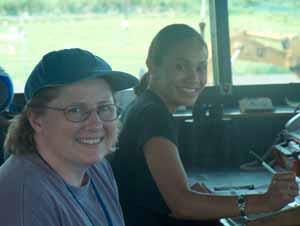 communications work between the various Air Traffic Controllers in the different countries. It helped me enormously to know the details behind a flight plan and HF position reports. I sincerely appreciate their time and help. I feel better now about crossing FIR boundaries and communicating position reports. By the way, Frank is also an old Mooney pilot!! He's been working the Pago Pago tower for 3 years.
communications work between the various Air Traffic Controllers in the different countries. It helped me enormously to know the details behind a flight plan and HF position reports. I sincerely appreciate their time and help. I feel better now about crossing FIR boundaries and communicating position reports. By the way, Frank is also an old Mooney pilot!! He's been working the Pago Pago tower for 3 years.
At left, Amy has been working and living in American Samoa for 10 years; she'll be returning to a tower in the US later this year. Ella is an American Samoan who is a trainee controller. Based on what I saw and heard, she's doing very well. Amy and Ella will be working the shift I leave.
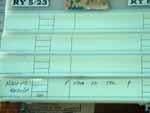
The strip has already been prepared for N220FC!!
I visited the weather office and they let me look at all their computer charts as well as access the charts I'd been looking at from the US. I hadn't looked forward to heading out without a briefing. The last satellite chart I had showed two major lows in the area. I was told they were cyclones but that I could pass between them after the first goes by. The newer charts showed that this was a distinct possibility. As this facility is open 24 hours a day, I'll return again this evening and Thursday morning before takeoff.
With a day off, it was time to visit a little. Frank had suggested taking the bus around, only 50cents. I walked a little then took a bus through a few towns. I'd seen school kids everywhere in various school uniforms. A teacher sat next to me and we talked for a while. There's a big push on education and every child goes to school. Most families speak English at home now although older people don't speak much English. I met two school girls who were seniors, below left in school uniform. Both were planning on continuing on to college.
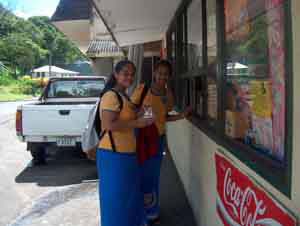

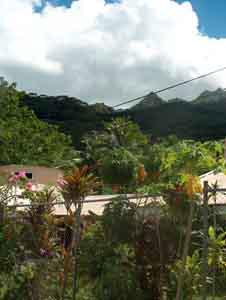
The trip by bus along the sea shore was beautiful, above center and right. Unfortunately, the locals didn't seem to appreciate it as much as I did. They were just on their normal daily commute by bus.

The buses, by the way, were fascinating. Each was different, with different colors, interior decorated with cloth, fur, carpets, etc and all had extremely LOUD music. You just tapped on the roof or back of the seat when you wanted to get off. I had a couple of hours of island tour for $2, not a bad afternoon.
The dash is covered with a carpet; when you get off, you toss your 50 cents or $1 on the carpet and step out. If you need change, you put down the $1 and pick up your change. The seats are hard, but they are up high, so you get a good view of everything around. I had fun.
Up at 5am and off to the weather station. Yes, there's a big gap between the two cyclones; the first is moving at 25k and the second at 12k, so the gap is widening. But the headwinds are 40-45 knots at the start of my trip and stay at 30-35k all the way down to NZ. Looks like I need to wait a little longer. The cyclones rotate clockwise down in the southern hemisphere, which takes a little getting used to. As the first one is passing, I have headwinds behind it, but tailwinds as the second approaches. Timing of this leg is critical if I want an 11 hour trip instead of another 15 hour leg.
Although all went well in the weather office the first few times, I was denied access later the second day. After my delayed departure due to the headwinds I had wanted another update on the cyclones and winds. Although he apologized profusely, I was not allowed to look at the weather information, nor would he give me a briefing as they had been told it was an FAA responsibility, not the weather service job. Actually, I had the same problem in Hawaii. FSS gave me a number to call in Honolulu for Pacific Ocean weather. When I called they said this was an unofficial briefing. It was excellent in content and interpretation. I asked how to receive an official briefing -- he said that could only be done by FSS. When I called FSS to file my flight plan and ask for a briefing, they said they couldn't brief the pacific weather and to call the weather bureau!! Catch 22 in Hawaii and American Samoa, it appears.
ALS:
While it was raining outside and I was waiting for the cyclones to advance and the winds to diminish I watched BBC World News. An Italian football (soccer) team is being investigated for drugs and an unusually high rate of Lou Gehrig's disease among it's players. Over the past 30 years, 32 team members have come down with ALS, Lou Gehrig's disease, more than coincidental. Doctors are investigating the link between drugs and the disease. Although the primary reason has been thought to be genetic, researchers believe that other teams statistics (and drug use) should be reviewed.
As I talk with people on this trip, I'm still amazed at how many know someone who has or had ALS. The Head Bellman, Allan, at one hotel in Hilo had a friend who had died of ALS. When I met the whale surveyors, as soon as I said ALS, they said Lou Gehrig's disease and how devastating it is.
If you are enjoying this trip via my web page, please consider donating to ALS on the dedication page. I'm covering all the costs of the trip, but my hope is that it will increase awareness and contributions to fighting and finding a cure to this destructive disease. To the many who have already donated, I thank you for your support.
Home / Dedication and Mission / Preparation / across the US to California / First ocean crossing to Hawaii /
Ocean crossing to Samoa / Ocean crossing and flying in New Zealand / Crossing and flying in Australia /
Multiple jumps: Singapore to South Africa / Multiple Jumps: South Africa to Greece / Europe /
Crossing the North Atlantic / Last leg home / About the pilot / About the plane / Supporters /
Overview / Women / Kids / FAQ / Lessons Learned / Family and Friends /
Flight reports: FL to CA / CA to HI / in Hawaii / HI to Am Samoa / Am Samoa to NZ / in NZ / NZ to AU / in AU / in AU2
AU to Singapore / Singapore to India / India to Seychelles / Seychelles to S.Africa / in South Africa / Zambia to Ethiopia /
Djibouti to Greece / Greece to France / England, Ireland, Scotland / to Iceland / to Greenland / to Canada / last legs home
New: Presentations / Book
I'm happy to hear from you, please email me at cagarratt@gmail.com any ideas, suggestions or flight tips. Thanks.
